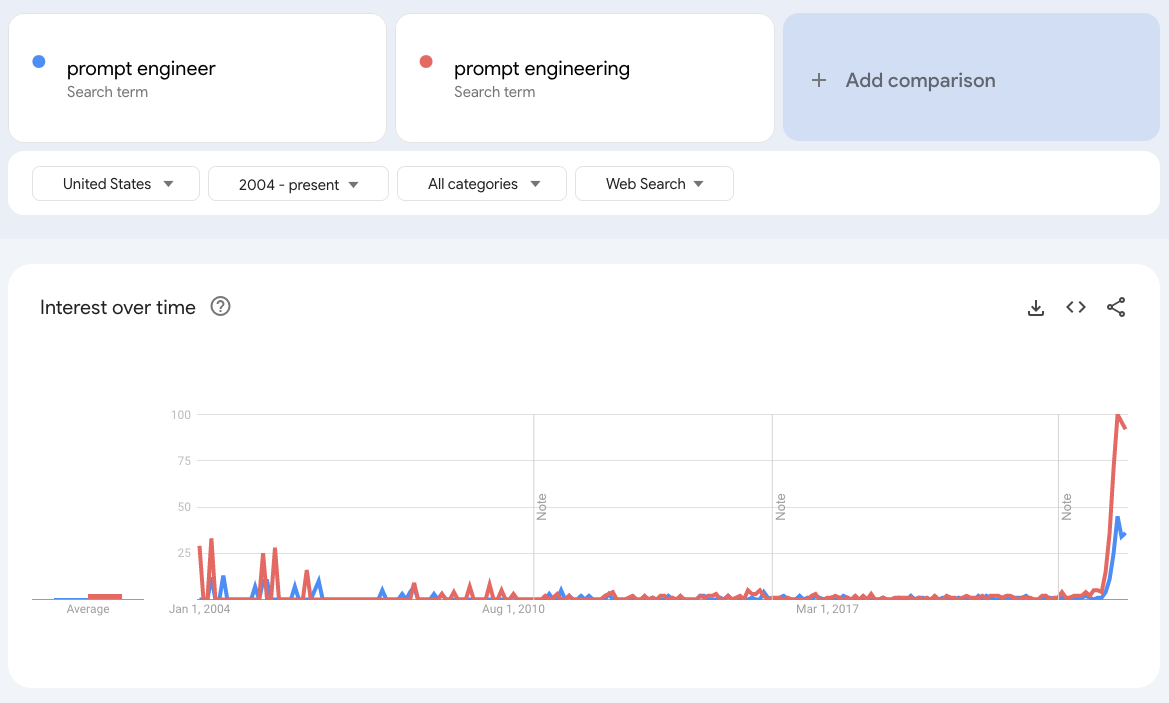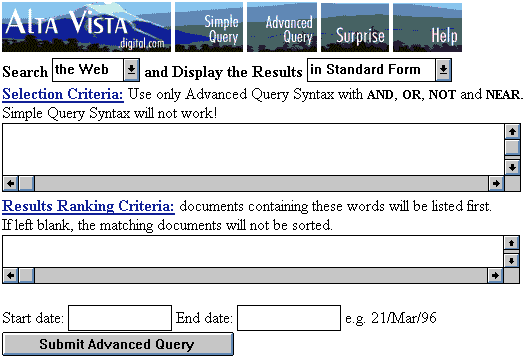The Short, Happy Life Of A Prompt Engineer
Also in Digital Marketing: AI, Design, Social Media & MUSIC MONDAY!
Generative AI is already creating a new job title: Prompt Engineer. And there’s a lot of interest in it.
With the explosive rise of generative AI, employers are shelling out for prompt engineering talent and the pay is pretty sweet.
A job posting for a "Prompt Engineer and Librarian" by AI company Anthropic seeks a candidate with "at least a high level familiarity with the architecture and operation of large language models" and pays from $175,000-$335,000 a year.
I’m like—daaaaaaammn!—should I be making a career pivot? I mean, I’ve been honing my prompt engineering skills using Midjourney, ChatGPT, and the rest.
I actually understand the rationale for the upper six-figures. Success as a prompt engineer requires a pretty diverse set of skills and knowledge.
Prompt Engineering Skills
These are some of the technical qualifications for the aforementioned Prompt Engineer job from Anthropic (this is the company behind Claude, the other major generative AI chatbot):
at least a high level familiarity with the architecture and operation of large language models.
at least basic programming skills and would be comfortable writing small Python programs.
It should be obvious that understanding how large language models work is an advantage for getting the most out of such a tool. And given generative AI’s talent for programming, having some programming chops would come in handy for providing instruction to the tool or in manipulating results.
But beyond programmers and data scientists, what knowledge and skills will help us mere mortals get the most out of generative AI?
I’ve been thinking a lot about this as I’ve been experimenting with ChatGPT, Bard, Bing Chat, Claude, Midjourney, DALL-E, Stable Diffusion and Runway.
Yes, it helps to understand how large language models work such as those that power ChatGPT and how the diffusion models that power image generators work.
Additionally, those who will have the most success using the consumer AI tools will have the following skills or knowledge.
Creative Vision
A clear understanding and vision of what you want to generate from the tool.
For image generators, being able to think visually, having a vision in your head of what you want to produce will go a long way.
For Chatbots, having a clear vision of the type of text you want to generate will help a great deal.
Broad-Based Knowledge
You will have an edge if you are an insatiably curious person because you are more likely to have a lot of different and varied interests.
If you have that, then you also likely have a broad base of knowledge. That broad base will help you connect dots between disparate bits of knowledge and that ability will help craft better prompts.
Vast Vocabulary
This should go without saying but the more words you know, the more capable you will be at manipulating the AI to give you what you want.
Language Skills
Clearly, the more capable you are at expressing yourself with the written word, the better you’ll be able to successfully generate what you want.
Empathy
This is most important when using chatbots in order to prime the AI for the perspective you want it to adopt. Check out Awesome ChatGPT Prompts for a huge set of examples that prompt the AI to adopt a role.
Cash In While You Can
The role of the Prompt Engineer will have a short shelf-life, so act now if you want to apply for an opening.
The Nielsen Norman Group identifies the history of user interfaces as segmented by three paradigms:
Batch processing,
Command-based interaction, and
Intent-based outcomes, which is where we are now with generative AI:
With this new UI paradigm, represented by current generative AI, the user tells the computer the desired result but does not specify how this outcome should be accomplished. Compared to traditional command-based interaction, this paradigm completely reverses the locus of control. I doubt we should even describe this user experience as an “interaction” because there is no turn-taking or gradual progress.
That said, in my science-fiction–illustration example, I’m not happy with the space suits. This might be fixed by another round with the AI. Such rounds of gradual refinement are a form of interaction that is currently poorly supported, providing rich opportunities for usability improvements for those AI vendors who bother doing user research to discover better ways for average humans to control their systems.
Do what I mean, not what I say is a seductive UI paradigm — as mentioned, users often order the computer to do the wrong thing. On the other hand, assigning the locus of control entirely to the computer does have downsides, especially with current AI, which is prone to including erroneous information in its results. When users don’t know how something was done, it can be harder for them to identify or correct the problem.
Remember when we had to understand boolean logic in order to get the best results from search engines?
Yeah, that was fun.
But then Google came around and started building the boolean operators into its algorithm, under the hood, and hidden from the user to simplify the interface and improve the search experience.
The same thing will happen eventually to generative AI interfaces, probably sooner than later.
So expect that the career of the Prompt Engineer to be a short, happy, and likely profitable one.
PAID SUBSCRIBERS: Look for an upcoming, rather lengthy piece, about the discoverability crisis AI poses for companies, brands, and creators, to be published soon.
Digital Marketing
Artificial Intelligence
ZDNet - Six skills you need to become an AI prompt engineer - Prompt engineering is fundamentally the creation of interactions with generative AI tools. Those interactions may be conversational, as you've undoubtedly seen (and used) with ChatGPT. But they can also be programmatic, with prompts embedded in code, the rough equivalent of modern-day API calls; except, you're not simply calling a routine in a library, you're using a routine in a library to talk to a vast large language model.
Some additional skills to ponder.
The Verge - Hope, fear, and AI - The Verge teamed up with Vox Media’s Insights and Research team and the research consultancy firm The Circus to poll more than 2,000 US adults on their thoughts, feelings, and fears about AI…For those who are using AI tools, creative experiments were most common. People are generating music and videos, creating stories, and tinkering with photos. More professional applications like coding were less common. And above all, people have simply been using AI systems to answer questions — suggesting chatbots like ChatGPT, Bing, and Bard may replace search engines, for better or worse.
One finding is particularly clear: AI is expanding what people can create. In every category we polled, people who used AI said they used these systems to make something they couldn’t otherwise, with artwork being the most popular category within these creative fields. This makes sense given that AI image generators are much more advanced than tools that create audio or video.
Bingo!
Creative Bloq - Bizarre AI Simpsons characters spark serious debate - Just a year after the first text-to-image AI art models began to emerge, the web is now so saturated with AI takes on popular cartoons and films (yes, mainly Wes Anderson) that it now barely raises an eyebrow. What a few months ago seemed like mindblowing alchemy has quickly become a bit 'meh'.
Sure the results look ever more photorealistic, but that's almost not impressive anymore. They still look weird and creepy, and they still look like AI. But a recent batch of AI-generated Simpsons characters has tapped into something that's actually quite a serious debate around the results generated by the best AI art generators.
You gotta check out the images! Many of Midjourney renditions of The Simpsons characters are not in-character, as it were. The Midjourney Marge, for example, is way too pretty than the actual cartoon Marge. The debate is essentially that Midjourney is incapable of creating ugly people because its training data is composed preponderantly of beautiful people.
Case in point: I was trying to create an image that would illustrate the concept of prompt engineering for this post. I combined a photo I took of a nearby lake with that of an architectural blueprint rendering. I did not ask for beautiful women to be included or even any people at all. But this is what I got:

9To5Google - Google says Project Tailwind is getting a new name, early access soon - Tailwind is a demo of the PaLM API that can help “anyone synthesizing information from many different sources” that they explicitly choose.
If this actually works, it will be a massive time-saver. We public relations professionals often need to digest large amounts of information to quickly grasp a new client’s business, technology or industry. Rather than plowing through dense and arcane academic papers for a technically-oriented client, for example, it would be far more productive to be able to condense and synthesize all that info.
On the other hand, being able to quickly and effortlessly synthesize and acquire a body of knowledge can be a dangerous thing. Studying is an effort. The more effort you put into something, the more respect you typically have for that thing. The companion of respect is responsibility.
TechCrunch - If the ‘Secret Invasion’ title credits aren’t an ethical use of AI art, what is? - This isn’t a facetious question; it’s an unanswered one. What, if anything, is an ethical way to use current generative AI in a major, public-facing work of art?
This quandary emerges from the furor regarding Marvel Studios’ use of AI to create the main title sequence of its latest show, “Secret Invasion.” AI generated art — in this climate? By a company with billions to spend? Unacceptable! But this is not quite the secret AI invasion it was initially characterized as.
While some revolted at first (and understandably) when they thought that Marvel had simply prompted Midjourney or Runway to create the opening sequence of a show with a nine-digit budget, the truth is considerably less villainous. This was a stylistic choice pitched and executed by professional artists who specifically aimed to evoke the sense of unease and imitation that pervades both the show and modern life.
As I continue to explore and experiment with generative AI, I am increasingly coming to the belief that the fears of AI replacing human creativity are overblown. Here’s the title sequence in question:
Vox - How Peter Jackson’s team made World War I footage look new - Over the past five years, Jackson tasked Park Road Post (a subsidiary of his production company WingNut Films) with adding color and sound to the archive footage, as well as making the frame rate consistent and similar to what we’d expect from footage shot today. The result is the new documentary “They Shall Not Grow Old,” which he said removes the “barrier between us and the actual people that were being filmed.”
This film was released in 2019 but I finally got a chance to watch it on Netflix last night. It’s a really remarkable achievement. In this interview with Kara Swisher discusses the creativity and storytelling possibilities that technology unlocks. This is part of the discussion we’re having about generative AI right now.
Lastly, I could not find any reference to it in the coverage of this film but while watching it, I swear some shots were constructed using still photography that was then animated using AI. This is an example of what I mean: A portrait of me as a toddler that was “brought to life” using AI. If you watch “They Shall Not Grow Old,” I think the scenes I’m referring to will jump out at you.
Design
I really love this series of movie poster-inspired episode graphics for the amazing Netflix series, “Black Mirror.” View the tweet.
Social Media
The Verge - Reddit is telling protesting mods their communities ‘will not’ stay private - Reddit has been pushing for protesting communities to reopen for weeks, telling them it would replace “inactive moderation,” “mods vandalizing communities,” and “subreddit squatters” with active mods. While many subreddits have reopened as normal, some have switched from private, which bars users from seeing any posts in the community, to restricted, where content is viewable but only certain users are allowed to post or comment.
When restricted, even if most users can’t post in a community, they can still see posts (which has the added benefit of making any links from that subreddit that show up in Google search results actually useful). But for the few that are holding out in private mode, it appears Reddit wants to change that.
And
TechCrunch - Reddit protest plunges user engagement, site activity and ad portal visits - On June 12, moderators responsible for managing thousands of subreddits (communities on the platform) protested against Reddit’s decision to charge developers for accessing data through its API. They showed their opposition by making their communities private and restricted.
That “blackout” movement, which briefly caused Reddit to go down, dropped daily traffic by about 7% and the amount of time people spent on the Reddit website by close to 16% between June 12 and 13, according to the data shared by web traffic analysis firm Similarweb. The criticism from some community moderators and users also resulted in a drop in daily visits to Reddit’s ad portal, which advertisers use to target their audience and drive promotional campaigns for Redditors.
Did Elon Musk give leaders of social media platforms license to royally screw things up, or what? And just when Reddit was really becoming interesting as an advertising vehicle.
LA Times - Influencer Caryn Marjorie is competing with her own AI to chat with fans - Social media influencer Caryn Marjorie recently launched an AI chatbot “clone” of herself — and not everyone is happy about it.
Including her, apparently? Heh. (Also see: Influencer AI.)
Us
Sunday Paper - On This Most American of Days, Anything Is Still Possible - Freedom in America means tolerance. It means freedom of speech, conscience, worship and thought. It also means responsibility and obligation to each other.
July 4th marks a milestone of human imagination and daring. It proclaims the possibility of a new birth of freedom and dignity for the human being. It also lays bare the contradictions and hypocrisies of our founding, while being an incandescent beacon in a moment that ruptured history.
The birth of the United States of America marks the beginning of an epoch. It was the start of a stupendous and unfolding story that, like all great stories, is made in parts from pain, joy, myth, triumph, failure, hypocrisy, good and evil. The story of America is the story of imperfect human beings forging ahead into the next moment on an unexplored frontier. It is a story about the battle of idealism and cynicism, of right and wrong, of justice and injustice.
More than anything, it is a love story.
Government of the People, by the People, for the People is a relatively new concept in the annals of human history. It was an utterly radical idea in 1776, and then there was a thunderclap. There were perfect words laid down on paper by a deeply imperfect man. They declared something remarkable that had never been said before. The men who signed the document containing them believed it likely that they were signing their death warrants. These words are transcendent, and it is what we celebrate on the night of July 4th with gratitude and joy.
Amen, brother.
Music Monday
Happy Independence Day! (Lyrics)




